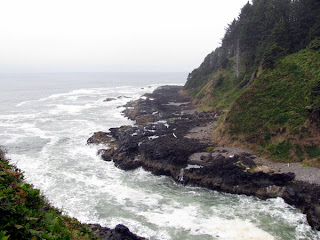Birdwatchers have many varieties to view on the rocks. Here is a sample.
One chilly day as we were exploring one of the state parks we came across a group of people in wet suits surfing in the water. We talked to one girl standing and shivering who reported that she heard the water temperature was 56 degrees! We didn't go down to the water!
Another interesting spot on the central coast was Devils Punchbowl, an oddly colored basalt formation with fascinating wave action.
A little north of Devils Punchbowl was Cape Foulweather. With a name like that we had to stop. It was named by Captain Cook when he landed in 1778 on a day of particularly inclement weather. The winds can reach 100 mph during storms. Fortunately it was only cloudy not stormy the day we stopped.
After two days of dreary weather the sun finally peeked out and the weather became magnificently clear. Our time at the northern part of the state was so much more enjoyable since we were able to see everything more clearly. The campground at Nehalem Bay State Park was also by the ocean but this time we could not see it from our campsite. We had to walk across some dunes to get to it.
One day we visited several lighthouses and the city of Tillamook. While there we stopped at the Tillamook Cheese factory and the Air Museum. The cheese factory is the largest on the coast and one of the top 10 attractions of Oregon. We followed the self guided tour, sampled some delicious cheeses, and enjoyed some yummy ice cream. The Air Museum is one of the largest wooden clear-span structures ever built with an area of over seven acres enough to play six football games. It was used in WWII to house blimps that guarded the coast against enemy submarines. It now houses privately owned WWII flying aircraft. We viewed a film which gave the history of the hanger, showed how it was built, and described some of the aircraft on display. We were impressed with how many planes that old were still in running condition. It was BIG!
The next day we went north to the beautiful town of Astoria which is situated on the mouth of the Columbia River. We took a guided Trolley ride and learned lots about the city's history and industry. The box in the front is the deisel generator that gave it its power.
Since it was such a beautiful day we decided to go up the hill to the Astoria Column to get a panoramic view of the ocean, rivers, and mountain. The murals on the outside depict the history of the region from 1792 to the arrival of the railroad in the 1880's. It was restored in 1995 and is a real work of art.
We climbed the 164 steps to the top and were thrilled with the magnificent view in all directions. The pictures just don't do it justice. (I accidentally clicked on the column picture again and can't get rid of it. Oops!)

We thoroughly enjoyed our visit to this lovely city. From the sounds of things we wouldn't want to be there in the winter!
From Astoria we took a drive to Fort Stevens State Park and went through the Military Museum. The military guarded the mouth of the Columbia River from when it was constructed during the the Civil War through WWII. We didn't take time to walk through the whole historical site since we had other stops we wanted to make. There are several small tourist towns along the northern coast. One neat one is Seaside, Oregon's first seashore resort, famous for its Promenade. It was quite busy when we were there so I can imagine how packed it gets in the summer since there seems to be every activity available to do. At the end of the road that leads to the beach is a sculpture that designates the end of the Lewis and Clark Trail.
One of the most spectacular ocean views we found on the northern coast was at Ecola State Park, south of Seaside. It was absolutely breathtaking watching the waves crash along the rocks. This view is looking north.
And this view is facing south.
This was the most unusual lighthouse that we saw. It was built on a rock 1.2 miles out in the ocean. It operated from 1880 until 1957 and is now a wildlife refuge.
We thoroughly enjoyed our stay and the coast of Oregon and looked forward to the Columbia River Gorge.













No comments:
Post a Comment